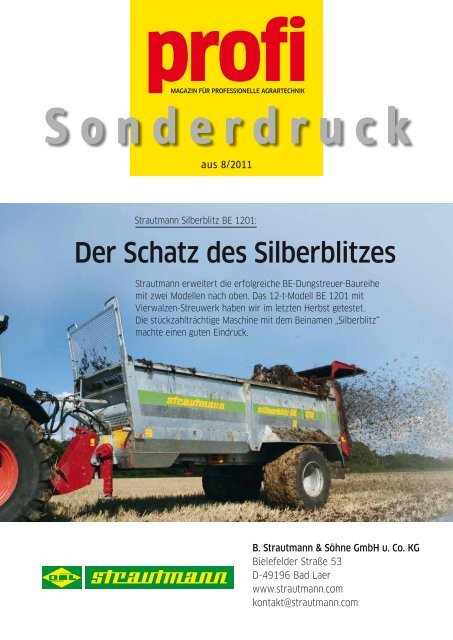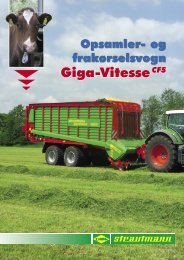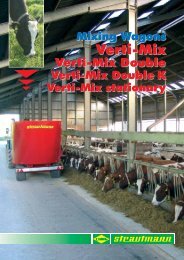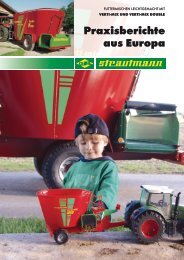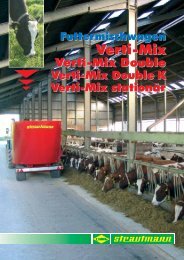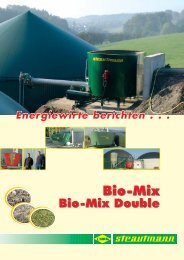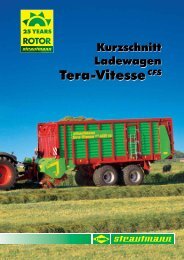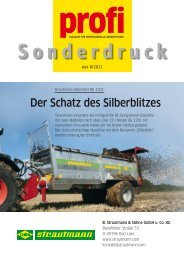profi-test_strautmann_be_with_translation.pdf (0.74 MB)
profi-test_strautmann_be_with_translation.pdf (0.74 MB)
profi-test_strautmann_be_with_translation.pdf (0.74 MB)
Sie wollen auch ein ePaper? Erhöhen Sie die Reichweite Ihrer Titel.
YUMPU macht aus Druck-PDFs automatisch weboptimierte ePaper, die Google liebt.
S o n d e r d r u c k<br />
aus 8/2011<br />
Strautmann Sil<strong>be</strong>rblitz BE 1201:<br />
Der Schatz des Sil<strong>be</strong>rblitzes<br />
Strautmann erweitert die erfolgreiche BE-Dungstreuer-Baureihe<br />
mit zwei Modellen nach o<strong>be</strong>n. Das 12-t-Modell BE 1201 mit<br />
Vierwalzen-Streuwerk ha<strong>be</strong>n wir im letzten Herbst ge<strong>test</strong>et.<br />
Die stückzahlträchtige Maschine mit dem Beinamen „Sil<strong>be</strong>rblitz“<br />
machte einen guten Eindruck.<br />
B. Strautmann & Söhne GmbH u. Co. KG<br />
Bielefelder Straße 53<br />
D-49196 Bad Laer<br />
www.<strong>strautmann</strong>.com<br />
kontakt@<strong>strautmann</strong>.com
<strong>profi</strong> PraxiStESt<br />
Der Strautmann<br />
BE 1201 bietet<br />
Schlagkraft<br />
<strong>be</strong>i gleich-<br />
zeitig präziser<br />
Verteilung.<br />
Fotos: Brüse<br />
Strautmann Sil<strong>be</strong>rblitz BE 1201:<br />
Der Schatz<br />
des Sil<strong>be</strong>rblitzes<br />
Strautmann erweitert die erfolgreiche BE-Dungstreuer-Baureihe<br />
mit zwei Modellen nach o<strong>be</strong>n. Das 12-t-Modell BE 1201 mit<br />
Vierwalzen-Streuwerk ha<strong>be</strong>n wir im letzten Herbst ge<strong>test</strong>et.<br />
Die stückzahlträchtige Maschine mit dem Beinamen „Sil<strong>be</strong>rblitz“<br />
machte einen guten Eindruck.<br />
Dungstreuer mit der Bezeichnung<br />
BE sind <strong>be</strong>i Strautmann<br />
schon lange erfolgreich im Pro-<br />
IDie<br />
gramm. Den kleineren Vorgänger<br />
BE 75 ha<strong>be</strong>n wir <strong>be</strong>reit in <strong>profi</strong> 9/05 ge<strong>test</strong>et.<br />
Die Fahrzeuge sind <strong>be</strong>i kleinen und mittleren<br />
Strukturen <strong>be</strong>liebt — zunehmend werden<br />
sie a<strong>be</strong>r auch von größeren Betrie<strong>be</strong>n<br />
nachgefragt, die präzise und zugleich einfache<br />
Streutechnik suchen. Ein Grund für<br />
Strautmann, die Baureihe — Streuer bis zu<br />
einer zulässigen Gesamtmasse von 9 t —<br />
nach o<strong>be</strong>n zu ergänzen und die <strong>be</strong>iden<br />
Modelle BE 1201 (zulässige Gesamtmasse<br />
maximal 13 t) und BE 1401 (zGM maximal<br />
15 t) mit etwa 80 cm längeren und 20 cm<br />
höheren Kästen anzubieten.<br />
Der BE 1201 macht von Beginn an einen<br />
soliden Eindruck: Vor allem tragen dazu<br />
das verzinkte Chassis und der e<strong>be</strong>nfalls verzinkte<br />
Aufbau <strong>be</strong>i. Untermauert wird das<br />
kernige Auftreten durch die optionale 800er<br />
Bereifung, die für einen Preis von 4 970 Euro<br />
(Vredestein Flotation Pro, günstigere Reifen<br />
anderer Marken sind <strong>be</strong>i Strautmann<br />
auch im Angebot; alle Preise ohne Mehrwertsteuer).<br />
Gekoppelt wird der Streuer ü<strong>be</strong>r die 80-mm-<br />
Kugel in Untenanhängung. Gegenü<strong>be</strong>r der<br />
in Deutschland standardmäßigen O<strong>be</strong>nanhängung<br />
in der Zugöse gibt Strautmann einen<br />
Aufpreis von 760 Euro an. Hinsichtlich<br />
des Fahrkomforts und der Materialschonung<br />
können wir diese Wunschausstattung nur<br />
empfehlen.<br />
www.<strong>profi</strong>.de
Die Gardero<strong>be</strong> ist zweckmäßig. Schöner wäre<br />
ein Aufstieg an der linken Seite. Das Schutzgitter<br />
hat inzwischen einen Handlauf — prima.<br />
Kratzbodenvorschub und Reversierung können<br />
von der Kabine aus erreicht werden.<br />
Ihren Teil zum Fahrkomfort trägt außerdem<br />
die serienmäßige Deichseldämpfung (<strong>be</strong>i<br />
<strong>be</strong>iden Anhängepositionen) ü<strong>be</strong>r PU-Blöcke<br />
<strong>be</strong>i. Die Deichsel der Baureihe BE 1201 und<br />
1401 stammt von der größeren VS-Serie.<br />
Sie ist schön schmal, enge Lenkeinschläge<br />
sind also kein Problem. Dank der verwendeten<br />
Weitwinkelgelenkwelle mit Nockenschaltkupplung<br />
von Walterscheid sind Wendemanöver<br />
auch während des Betrie<strong>be</strong>s<br />
möglich. Wird die Maschine abgestellt,<br />
lässt sich die Gelenkwelle in einem<br />
ordentlichen Halter ablegen.<br />
<strong>profi</strong> 8/2011<br />
Nicht ganz so optimal<br />
war die Parkposition<br />
der gekennzeichneten<br />
Ölschläuche. Denn die<br />
Nuten zum Einhängen der<br />
Schläuche waren zu<br />
passgenau, das hat<br />
Strautmann inzwischen geändert. Prinzi piell<br />
ist die längs- und höhenverstellbare Gardero<strong>be</strong><br />
mit dem daran angebrachten Stellventil<br />
für die Kratzbodengeschwindigkeit, dem<br />
Knauf für den Kratzbodenrücklauf und dem<br />
Bremskraftregler a<strong>be</strong>r prima. Auch die<br />
Schlauchführung durch einige Ösen ist gut.<br />
Außerdem gibt es vorne links den Absperrhahn<br />
gegen ungewolltes Senken der Heckklappe<br />
und natürlich<br />
auch die Zweigang-Abstellstütze.<br />
Deren Kur<strong>be</strong>l<br />
fehlt eine Parkposition.<br />
Hier wird Strautmann<br />
nach<strong>be</strong>ssern.<br />
Ein weiterer Kritikpunkt<br />
ist die Position der Aufstiegsleiter<br />
auf der rechten<br />
Seite. Strautmann argumentiert, dass es<br />
mit Leiter und Stützfuß auf einer Seite zu<br />
eng wäre. Und da der Stützfuß öfter als der<br />
Aufstieg gebraucht wird, wurde er links positioniert.<br />
Der Aufstieg selbst ist a<strong>be</strong>r gut,<br />
Lob gibt es dafür, dass er sich vorne vor dem<br />
Kasten und nicht seitlich <strong>be</strong>findet. Auf die<br />
Kritik der Verletzungsgefahr am Schutzgitter<br />
(Praxis<strong>test</strong> des BE 75) hat Strautmann<br />
reagiert und dem Schutzgitter inzwischen<br />
einen Handlauf spendiert — super. Der<br />
schwierige Einstieg in den Aufbau bleibt<br />
a<strong>be</strong>r, denn das Gitter ist hoch, und die Neigung<br />
der Stirnwand in Fahrtrichtung macht<br />
es nicht einfacher.<br />
Der Boden <strong>be</strong>steht aus Kunststoff, ü<strong>be</strong>r den<br />
Ketten und Material gut gleiten können. Die<br />
Ketten sind stabil, die Profile ü<strong>be</strong>r den Leisten<br />
sollen das Aufschwimmen der Kette<br />
verhindern.<br />
als Leistungs<strong>be</strong>darf gibt Strautmann für<br />
den Sil<strong>be</strong>rblitz genau 100 PS an. Wir ha<strong>be</strong>n<br />
den Streuer oft an einem Valtra N 121<br />
mit 126 PS eingesetzt und sind <strong>be</strong>quem klargekommen.<br />
Allerdings war es nicht verkehrt,<br />
<strong>be</strong>ispielsweise an Steigungen oder <strong>be</strong>i<br />
sehr schwerem Mist, Reserven zu ha<strong>be</strong>n.<br />
Als gestrichenes Maß ha<strong>be</strong>n wir ein Kastenvolumen<br />
von 8,8 m 3 errechnet. Als maxima-<br />
tESturtEiLEI<br />
So <strong>be</strong>wertet <strong>profi</strong> den<br />
Strautmann BE 1201<br />
Nutzlast B<br />
Ladevolumen Z<br />
Leistungs<strong>be</strong>darf B<br />
Verteilung von Stallmist B<br />
An-/Abbau B<br />
Beladen BB<br />
Einstellen Streumenge B<br />
Anfahrschutz B<br />
Verar<strong>be</strong>itung/Lackierung B/B<br />
Wartung/Reinigung B/B<br />
Benotung: BB = sehr gut; B = gut;<br />
Z = durchschnittlich; E = unterdurch–<br />
schnittlich; EE = mangelhaft<br />
les Ladevolumen gibt Strautmann <strong>be</strong>im<br />
Vierwalzen-Streuwerk 12 m 3 an. Lädt man<br />
den Streuer mit schwerem Rindermist also<br />
voll aus, ist der leer gut 4,5 t schwere BE<br />
1201 mit einer Nutzlast von etwas mehr als<br />
8,4 t sicher ü<strong>be</strong>rladen. Bei leichten Streugütern<br />
könnte es schwierig werden, die Maschine<br />
gewichtsmäßig auszuladen. Optional<br />
gibt es für solche Fälle eine Bordwand-<br />
erhöhung von 25 cm für einen Aufpreis von<br />
570 Euro.<br />
Die Ü<strong>be</strong>rladehöhe von 2,54 m mit Reifen der<br />
Größe 800/45 R 26.5 ist auch mit Standardfrontladern<br />
gut zu ü<strong>be</strong>rbrücken. Sind Räder<br />
der Größe 710/45 R 22.5 (2 950 Euro) montiert,<br />
<strong>be</strong>trägt die Ü<strong>be</strong>rladehöhe nach Herstelleranga<strong>be</strong>n<br />
nur 2,33 m. Ein aufgeschraubter<br />
Kantenschutz aus Kunststoff<br />
schützt sowohl die Schwinge als auch den<br />
Streuer, hier hätten wir uns nur eine etwas<br />
stärkere Leiste gewünscht, die mehr Verschleißmasse<br />
bietet.<br />
Das dreieckige Blech zwischen Streuaggregat<br />
und Bordwando<strong>be</strong>rkante verhindert<br />
zuverlässig Materialstauungen.<br />
Eine möglichst gleichmäßige Beladung war<br />
<strong>be</strong>i der Testmaschine gefordert, denn ein<br />
Stauschie<strong>be</strong>r war nicht vorhanden. Laut<br />
Strautmann kann a<strong>be</strong>r jederzeit ein Stauschie<strong>be</strong>r<br />
nachgerüstet werden, dafür wären<br />
dann 1 720 Euro zu <strong>be</strong>zahlen.<br />
www.<strong>profi</strong>.de
Das Vierwalzen-Streuwerk liefert eine ordentliche<br />
Ar<strong>be</strong>it, je zwei Walzen drehen zueinander.<br />
Der Antrieb der Walzen erfolgt von unten.<br />
Die Ausräumer am unteren Ende der Streuwalzen<br />
halten den Bereich von Ablagerungen frei.<br />
Insgesamt lagert sich wenig Material auf dem<br />
Vierwalzen-Streuwerk<br />
ab, was herunterfallen<br />
könnte. Dank der<br />
nach unten versetzten<br />
Anordnung wird<br />
der Kasten vollkommen<br />
geleert.<br />
Lob gibt es für die Fahreigenschaften auf<br />
der Straße. Trotz ungefederter Achse liegt<br />
der BE 1201 „wie ein Brett“, und auch <strong>be</strong>i<br />
nicht ganz geleertem Aufbau ü<strong>be</strong>rträgt sich<br />
jederzeit genügend Stützlast auf den Schlepper,<br />
so dass auch das Fahren auf schlechteren<br />
Wegen noch in Ordnung ist. Ihren Teil<br />
trägt natürlich auch die Untenanhängung in<br />
der Kugel <strong>be</strong>i.<br />
Nur der Platz in den vor den Rahmen geschraubten<br />
Radkästen ist knapp. Die 800er<br />
Bereifung reizt den Raum aus. Nach o<strong>be</strong>n<br />
bleibt nur etwa eine Handbreit Platz unter<br />
dem Rahmen<strong>profi</strong>l. Hier wird es also eng,<br />
wenn Mist und Boden am Reifen haften.<br />
MESSwErtEI<br />
Strautmann BE 1201<br />
Länge 7,47 m<br />
Breite 2,71 m<br />
Höhe (Schutzgitter/<br />
ü<strong>be</strong>r Streuwerk) 3,42/3,04 m<br />
Leergewicht 4 570 kg<br />
Nutzlast 8 430 kg<br />
Zulässige Gesamtmasse 13 000 kg<br />
Ü<strong>be</strong>rladehöhe 2,54 m<br />
Kastenlänge (unten/o<strong>be</strong>n) 5,02/5,27 m<br />
Kastenhöhe 0,95 m<br />
Kastenbreite 1,80 m<br />
Kastenvolumen (gestrichen) 8,8 m 3<br />
Höhe Streuwalzen 1,50 m<br />
Walzendurchmesser<br />
innen/außen 10/51 cm<br />
Durchgangsbreite/-höhe 1,80/1,27 m<br />
Kratzboden-<br />
geschwindigkeit 0 bis 5,6 m/min<br />
Ketten 4 Stück 13 x 55 mm<br />
Leistenmaß/Breite 60 x 30 mm/71 cm<br />
Hydraulikanschlüsse 1 dw/1 ew<br />
Bereifung 800/45 r 26.5<br />
Preis<br />
- Serienausstattung (o. MwSt.) 29 370 €<br />
- Testausstattung (o. MwSt.) 32 600 €<br />
<strong>profi</strong> 8/2011<br />
Schön wäre es, wenn die Radabdeckungen<br />
ganz ü<strong>be</strong>r die Reifen greifen würden. An der<br />
Testmaschine waren sie rund zehn Zentimeter<br />
zu schmal, andererseits sind sie so<br />
nicht anfahrgefährdet.<br />
Wo wir <strong>be</strong>im Thema Straßenfahrt sind: Licht<br />
und Schatten gibt es <strong>be</strong>i der Heckklappe. Die<br />
Verschmutzung der Straße verhindert die<br />
Heckklappe nicht. Zur Seite und nach unten<br />
schließt sie nicht bündig ab und kann daher<br />
ein Herabfallen von Ladungsresten nicht<br />
verhindern, laut Strautmann soll sie in erster<br />
Linie auch als Anfahrschutz dienen.<br />
Gut ist dagegen die Beleuchtung auf der<br />
Heckklappe. Denn dort sitzt sie gegen Anfahrschäden<br />
und Verschmutzung geschützt.<br />
auf dem Feld schwenkt man zunächst mit<br />
einer ew-Funktion die Heckklappe hoch.<br />
Dann wird das Streuwerk mit 540er Zapfwellendrehzahl<br />
angestellt und der hydraulische<br />
Kratzbodenvorschub gestartet. Der<br />
Kratzboden wird von der rechten Seite mit<br />
einem Ölmotor angetrie<strong>be</strong>n. Die vier Streuwalzen<br />
werden ü<strong>be</strong>r Winkelgetrie<strong>be</strong> von unten<br />
mit Kraft versorgt, dazu gibt es unter<br />
dem Wagen einen mehrfach gelagerten<br />
Durchtrieb für die Gelenkwelle.<br />
Die Kratzbodengeschwindigkeit wird ü<strong>be</strong>r<br />
einen Regler vorn an der Gardero<strong>be</strong> eingestellt.<br />
Eingestanzte Zahlen auf dem griffigen<br />
Reglerknauf dienen der Orientierung. Die<br />
Regulierung erfolgt unserer Meinung nach<br />
feinfühlig genug. Eine Elektro<strong>be</strong>dienung gibt<br />
es für einen Mehrpreis von 1 855 Euro.<br />
Die Heckklappe schließt nicht dicht, die daran<br />
montierte Beleuchtung ist gut, der Unterfahrschutz<br />
ist stabil. Der Ölmotor für den Kratz -<br />
boden ist rechts angebracht.<br />
Empfehlen können wir die 800er Bereifung, die<br />
die Platzverhältnisse im Radkasten allerdings<br />
ausreizt.<br />
Ist man ü<strong>be</strong>rs Ziel hinausgeschossen, kann<br />
der Kratzboden auch zurückgezogen werden,<br />
indem ein Taster auf der Steuereinheit<br />
mit einigem Kraftaufwand gedrückt wird.<br />
Wohl dem Fahrer, der lange Arme hat, denn<br />
Steuergerät und Taster müssen zeitgleich<br />
<strong>be</strong>tätigt werden. Da das nicht immer gelingt,<br />
kann man den Vorschub auch erst komplett<br />
zudrehen, dann Öl ge<strong>be</strong>n und reversieren.<br />
Anschließend die Drossel wieder öffnen,<br />
den Ölumlauf aktivieren und weiterfahren.<br />
Die vier aufrecht stehenden, leicht nach<br />
vorn geneigten 1,50 m hohen Streuwalzen<br />
(Streuwerk baugleich mit kleineren Maschinen)<br />
verteilten die Streugüter während<br />
www.<strong>profi</strong>.de
<strong>profi</strong> PraxiStESt<br />
des Tests gut. Dazu drehen sie paarweise<br />
zueinander, um auch mittig hinter dem<br />
Streuer ein gleichmäßiges Ar<strong>be</strong>itsbild zu<br />
erzielen. Je Walze sind zwölf tauschbare<br />
Streuwerkzeuge mit je fünf Zähnen montiert.<br />
Bei Verschleiß können diese gedreht<br />
werden. Ganz egal ob frisch oder länger abgelagerter<br />
Stallmist oder auch verhältnismäßig<br />
leichter Pferdemist — an der Verteilung<br />
hatten wir nichts auszusetzen. Die DLG<br />
hat für dieses Streuwerk unter standardisierten<br />
Test<strong>be</strong>dingungen sowohl für die<br />
Längs- als auch für die Querverteilung<br />
einen guten Variationskoeffizienten von<br />
unter 20 % (<strong>profi</strong> 9/2005) ermittelt.<br />
Nach unten ha<strong>be</strong>n die Walzen einen schönen<br />
Ausräumer, der die Basis der Schnecken<br />
stets sau<strong>be</strong>r hält und allzu große Ver-<br />
Die Ü<strong>be</strong>rladehöhe liegt <strong>be</strong>i der großen Bereifung <strong>be</strong>i gut 2,50 m.<br />
Die Reibleiste aus Kunststoff könnte etwas stärker sein.<br />
schmutzungen unterbindet. Da die Walzen<br />
ein Stück nach unten versetzt sind, ist eine<br />
vollständige Restentleerung sichergestellt.<br />
Den Durchgang vor dem Streuwerk ha<strong>be</strong>n<br />
wir mit 1,80 m Breite und 1,27 m Höhe notiert.<br />
Für das von uns ge<strong>test</strong>ete Streuwerk<br />
ist ein Aufpreis von 2 120 Euro zu <strong>be</strong>zahlen,<br />
serienmäßig wird ein liegendes Zweiwalzen-<br />
Streuwerk geliefert.<br />
Die von Strautmann angege<strong>be</strong>nen Ar<strong>be</strong>itsbreiten<br />
von ca. 6 bis 8 m sind passend. Je<br />
nach Streumaterial kann es vorkommen, für<br />
optimalen Anschluss durch <strong>be</strong>reits gestreute<br />
Flächen zu fahren. Das soll laut Strautmann<br />
allerdings nur passieren, wenn die<br />
Zapfwellendrehzahl zu hoch ist.<br />
Gefördert wird das Material ü<strong>be</strong>r den<br />
hervorragenden Kunststoffboden des BE<br />
1201, der aus einzelnen Kunststoffbrettern<br />
<strong>be</strong>steht. Er ist glatt, widerstandsfähig und<br />
<strong>profi</strong> 8/2011<br />
lässt das Material sowie die Ketten gut gleiten<br />
und ist vermutlich recht verschleißarm.<br />
Nach der Saison ha<strong>be</strong>n wir jedenfalls keine<br />
Schäden festgestellt. Für die BE 1201- und<br />
1401-Streuer gehört dieser Boden zur<br />
Serienausstattung.<br />
Auch die vier 13 x 55-mm-Kratzbodenketten<br />
machen einen stabilen Eindruck. Zwischen<br />
den Kettenstränge sind U-Profile von<br />
71 cm Breite als Kratzbodenleisten verschraubt.<br />
Auf jede dritte Leiste schweißt Strautmann<br />
eine Art Dach<strong>profi</strong>l. Bei leichten, krüme ligen<br />
Gütern verhindern diese das Aufschwimmen<br />
der Kette. Die Idee ist gut, allerdings lässt<br />
sich der Bereich zwischen Leiste und Profil<br />
kaum reinigen, so dass hier Korrosion entstehen<br />
könnte.<br />
Sehr gut gefallen hat uns die automatische<br />
Kettenspannung, deren Spanner an der<br />
Frontwand angeordnet sind. Gute Aufkle<strong>be</strong>r<br />
ge<strong>be</strong>n Auskunft ü<strong>be</strong>r Funktions- und Verstellmöglichkeiten.<br />
Die offenen Kettennüsse<br />
ha<strong>be</strong>n uns e<strong>be</strong>nfalls zugesagt, weil hier<br />
alles sau<strong>be</strong>r bleibt. Ein Pluspunkt für die<br />
Funktionssicherheit.<br />
Zum rahmen und aufbau: Der verzinkte<br />
Rahmen ist aus einem Stück gekantet. Unter<br />
der Maschine bleibt es von vornherein<br />
recht sau<strong>be</strong>r. Es gibt nur wenige Stellen, wo<br />
sich etwas ablagern kann. Und diese Bereiche<br />
sind dank der guten Zugänglichkeit<br />
auch einfach zu reinigen. Nur an der hinteren<br />
Umlenkung des Kratzbodens lagert sich<br />
etwas mehr Material ab. Aufgeschleuderter<br />
Dreck der Schlepperhinterreifen wird durch<br />
ein vorn an der Maschine montiertes Blech<br />
ferngehalten.<br />
Der e<strong>be</strong>nfalls verzinkte Aufbau aus 3-mm-<br />
Blech ist aus einem Stück gekantet, hat drei<br />
Rungen und wirkt stabil und langlebig.<br />
Einziges Manko ist seine fixe Montage.<br />
Details in Kurzfassung:<br />
■ Fast alle notwendigen Schmierstellen sind<br />
gut zu erreichen. Teils erleichtern Schmierleitungen<br />
die Ar<strong>be</strong>it. Nur der Schmiernippel<br />
für die hintere Kratzbodenumlenkrolle ist<br />
hinter dem Ölmotor schwer zu finden.<br />
■ Serienmäßig wird der BE 1201 mit einer<br />
40-km/h-Ausstattung samt Unterfahrschutz<br />
und Radabdeckungen geliefert.<br />
Fazit: Der Strautmann BE 1201 machte in<br />
unserem Praxis<strong>test</strong> einen wirklich guten<br />
Eindruck. Die Maschine ist schlicht und zu-<br />
Die Deichsel ist ü<strong>be</strong>r PU-Blöcke gedämpft. Die Kratzboden -<br />
spannung erfolgt automatisch.<br />
gleich schlagkräftig. Die direkte Bedienung<br />
ü<strong>be</strong>r die Schleppersteuerventile ist einfach.<br />
Aufwändige elektrische Steuerungen sucht<br />
man vergeblich, das macht die Maschine<br />
auch für den Verleih interessant. Zudem ist<br />
die Ü<strong>be</strong>rladehöhe noch moderat.<br />
Das Streubild des Vierwalzen-Streuwerkes<br />
ist gut, einziges Manko hier sind die Anschlussfahrten<br />
durch <strong>be</strong>reits <strong>be</strong>streute Flächen.<br />
Das lässt sich laut Strautmann mit der<br />
540er Zapfwelle abstellen. Empfehlen können<br />
wir die 800er Bereifung, die den Boden<br />
schont und auch für Fahrkomfort sorgt.<br />
Wenn Strautmann es schafft, die Platzprobleme<br />
zu <strong>be</strong>seitigen, wäre das noch <strong>be</strong>sser.<br />
Insgesamt ist der BE 1201 eine interessante<br />
Maschine zu einem Preis für die Testausstattung<br />
von 32 600 Euro — für manchen<br />
Betrieb e<strong>be</strong>n ein Schatz, der Sil<strong>be</strong>rblitz.<br />
Christian Brüse<br />
www.<strong>profi</strong>.de<br />
<strong>profi</strong> · 48084 Münster · Internet: www.<strong>profi</strong>.de · E-Mail: service@<strong>profi</strong>.de · Telefon +49 (0)2501/801-69 61 · Telefax +49 (0)2501/801-3 59
Kurzschnittladewagen Giga-Vitesse CFS<br />
CFS-Video auf<br />
www.<strong>strautmann</strong>.com<br />
und Super-Vitesse CFS<br />
B. Strautmann & Söhne GmbH u. Co. KG · D-49196 Bad Laer<br />
Bielefelder Straße 53 · Tel. +49(0 )54 24/8 02-0 · Fax +49(0 )54 24/8 02 76<br />
kontakt@<strong>strautmann</strong>.com · www.<strong>strautmann</strong>.com
Strautmann Sil<strong>be</strong>rblitz BE 1201:<br />
The Treasure of Sil<strong>be</strong>rblitz<br />
Strautmann is expanding the successful BE manure spreader product range by two models.<br />
We <strong>test</strong>ed the 12 t model BE 1201 <strong>with</strong> four-drum spreading unit last autumn. The machine<br />
called "Sil<strong>be</strong>rblitz" (note of transl.: in English: silver lightning) is able to handle a large<br />
num<strong>be</strong>r of items and made a good impression.<br />
The BE manure spreaders have <strong>be</strong>en part of the successful Strautmann programme for a<br />
long time. We <strong>test</strong>ed the smaller predecessor BE 75 already in <strong>profi</strong> 9/05. The wagons are<br />
popular <strong>with</strong> small and medium-sized establishments - but are now also in growing demand<br />
by larger enterprises looking for both precise and easy-to-handle spreading technology. One<br />
reason for Strautmann to expand its spreader series up to a gross vehicle weight rating of 9 t<br />
and to offer the two models BE 1201 (max. gross vehicle weight rating 13 t) and BE 1401<br />
(max. gross vehicle weight rating 15 t) equipped <strong>with</strong> approx. 80 cm longer and 20 cm higher<br />
cases.<br />
From the very <strong>be</strong>ginning, the BE 1201 makes a solid impression: Above all, the<br />
galvanized chassis and the body which is also galvanized contribute to this. The robust<br />
appearance is substantiated by the optional 800-type tyres available at a price of 4,970 Euro<br />
(Vredestein Flotation Pro, less expensive tyres of other manufacturers are also on offer by<br />
Strautmann, all prices plus VAT).<br />
The spreader is hitched by means of the 80mm ball head in bottom linkage. Strautmann<br />
indicates an extra cost of 760 Euro compared to the German standard top linkage <strong>with</strong><br />
drawbar lug. With regard to driving comfort and material protection, we can only recommend<br />
this optional equipment.<br />
Furthermore, the standard drawbar shock absor<strong>be</strong>r (for both hitching positions) by means of<br />
PU blocks increases the driving comfort. The drawbar of the BE 1201 and 1401 series is<br />
from the larger VS series. It is rather narrow such that tight steering angles are no problem.<br />
Thanks to the used wide-angle propeller shaft <strong>with</strong> Walterscheid cam-type cut-out clutch,<br />
turning manoeuvres are also possible during operation. If the machine is parked, the<br />
propeller shaft can <strong>be</strong> put down onto a usual holder.<br />
The parking position of the marked oil hoses was not that optimal. The grooves for hanging<br />
the hoses were too precise; Strautmann has modified this in the meantime. But in general,<br />
the longitudinally and height adjustable holder <strong>with</strong> the mounted control valve for the scraper<br />
floor speed, the knob for scraper floor reverse and the brake pressure regulator is fantastic.<br />
The hose guide through several eyes is good, too. Furthermore, a stop valve to prevent<br />
unintentional lowering of the tailgate is mounted at the left-hand front and the machine is, of<br />
course, equipped <strong>with</strong> the variable parking support adjustable at two speeds. Its crank<br />
handle lacks a parking position. Strautmann will remedy this.<br />
Another point of criticism is the position of the ladder on the right-hand side. Strautmann<br />
argues that the ladder and the supporting leg on the same side would take up too much<br />
space. And as the supporting leg is used more often than the ladder, it has <strong>be</strong>en positioned<br />
on the left-hand side. However, the ladder itself is good; its position in front of the case and<br />
not on the side was praised. Strautmann has reacted to the criticized risk of injuries caused<br />
by the protective grating (practical <strong>test</strong> of BE 75) by providing the protective grating <strong>with</strong> a<br />
handrail - great. It remains, however, difficult to enter the body, as the grating is high and the<br />
inclination of the front panel in direction of motion does not make it easier.<br />
According to Strautmann, the power required for the Sil<strong>be</strong>rblitz is exactly 100 HP. We<br />
often used the spreader hitched to a Valtra N 121 <strong>with</strong> 126 HP and easily got by. It was not<br />
bad, though, to have still some reserve e.g. when travelling uphill or when transporting very<br />
heavy manure. As level measure, we have calculated a case capacity of 8.8 m 3 . According to<br />
Strautmann, the maximum loading capacity <strong>with</strong> the four-drum spreading unit is 12 m³. If the
spreader is tightly charged <strong>with</strong> heavy cow dung, the BE 1201 <strong>with</strong> an empty weight of more<br />
than 4.5 t will <strong>be</strong> certainly overloaded <strong>with</strong> a payload of slightly more than 8.4 t. Light<br />
spreading materials might make it difficult to use the loading capacity at its optimum. For<br />
such cases, an optional side panel attachment of 25 cm is available at an extra cost of 570<br />
Euro.<br />
The discharge height of 2.54 m <strong>with</strong> 800/45 R 26.5 tyres can <strong>be</strong> well handled even by means<br />
of standard front loaders. If 710/45 R 22.5 (2,950 Euro) tyres are mounted, the discharge<br />
height is only 2.33 m according to the manufacturer's specifications. A screwed-on plastic<br />
edge protector protects both the shifting arm and the spreader, but we would have preferred<br />
a somewhat stronger strip offering more wearing substance.<br />
The triangular sheet metal plate <strong>be</strong>tween spreading unit and top edge of the side panel<br />
reliably prevents material from piling up.<br />
The <strong>test</strong> machine required a charging as equally as possible as it was not equipped <strong>with</strong> a<br />
retaining slide. According to Strautmann, a retaining slide can <strong>be</strong> retrofitted at any time at a<br />
price of 1,720 Euro.<br />
The driving characteristics on the road are praised. Despite an unsprung axle, the BE<br />
1201 lies "like a board" on the road, and even <strong>with</strong> a body not completely emptied, there is<br />
always sufficient tongue load <strong>be</strong>ing transferred to the tractor such that even driving on poor<br />
stretches is still OK. Of course, the bottom linkage in the ball head contributes to this. Only<br />
the space in the wheel housings screwed onto the frame is tight. The 800-type tyres exhaust<br />
the space. At the top, there is only a hand's width of space <strong>be</strong>low the frame section such that<br />
it will get tight when manure and clods adhere to the tyres.<br />
It would <strong>be</strong> nice if the wheel guards completely covered the tyres. On the <strong>test</strong> machine, they<br />
were by about ten centimetres too small; on the other hand they do not risk bumping that<br />
way.<br />
While we are on the subject of road travel: The tailgate is characterized by light and shade.<br />
The tailgate does not prevent the road from <strong>be</strong>ing soiled. It is not flush <strong>with</strong> the side and the<br />
bottom and is therefore not able to avoid cargo residues from falling down; according to<br />
Strautmann, it is intended to serve above all as a bumper buffer.<br />
On the other hand, the lighting at the tailgate is good, <strong>be</strong>ing protected there against collision<br />
damages and soiling.<br />
On the field, the tailgate is first swivelled up by means of a single-acting function.<br />
Then, the spreading unit is switched on at 540-type p.t.o. shaft speed and the hydraulic<br />
scraper floor feed is started. The scraper floor is powered by an oil motor from the right-hand<br />
side. The four spreading drums are supplied <strong>with</strong> power from the bottom by means of<br />
angular gears, a multi-mounted drive shaft for the propeller shaft having <strong>be</strong>en installed for<br />
this purpose <strong>be</strong>neath the wagon.<br />
The scraper floor speed is set via a regulator mounted at the front of the holder. Stamped-in<br />
num<strong>be</strong>rs on the handy regulator knob serve as points of reference. In our opinion, the<br />
regulation is smooth enough. An electrical operating device is available at an extra cost of<br />
1,855 Euro.<br />
When having overshot the mark, the scraper floor can <strong>be</strong> retracted by pressing a key button<br />
at the control unit <strong>with</strong> some effort. Happy is the driver whose arms are long enough to<br />
simultaneously operate the control device and the key button. As this is not always<br />
successful the feed function can also first <strong>be</strong> completely stopped, <strong>be</strong>fore switching the oil<br />
supply on and reversing. Then open the throttle again, activate the oil circulation and<br />
continue your travel.<br />
The four spreading drums in upright position slightly inclined to the front <strong>with</strong> a height<br />
of 1.50 m (spreading unit design identical to that of smaller machines) well distributed the<br />
spreading materials during the <strong>test</strong>. For that purpose, they rotate towards each other in pairs,<br />
in order to produce a homogeneous spreading pattern even in the centre <strong>be</strong>hind the<br />
spreader. Twelve exchangeable spreading tools <strong>with</strong> five teeth each are mounted on each<br />
drum. In case of wear, the tools can <strong>be</strong> turned over.
Whether fresh or mature manure or relatively light horse dung - we did not find any fault <strong>with</strong><br />
the distribution. For this spreading unit, the DLG (note of transl.: German Agricultural Association)<br />
determined a good variation coefficient of less than 20 % (<strong>profi</strong> 9/ 2005) both for lengthwise<br />
and lateral distribution under standardized <strong>test</strong> conditions. At the bottom, the drums are<br />
equipped <strong>with</strong> a nice cleanout device which always keeps the auger base clean and avoids<br />
too heavy soiling. Complete emptying is ensured thanks to the arrangement of the drums<br />
which are slightly offset to the bottom. We noted a width of 1.80 m and a height of 1.27 m for<br />
the spreading unit clearance. The spreading unit <strong>test</strong>ed by us is available at an extra cost of<br />
2,120 Euro, the standard version of the machine is delivered <strong>with</strong> a two-drum spreading unit<br />
in horizontal position.<br />
The operating widths of approx. 6 to 8 m specified by Strautmann are convenient. Depending<br />
on the spreading material, it may <strong>be</strong> necessary to travel across already spread surfaces, in<br />
order to achieve optimum connection. According to Strautmann, this is said to happen only if<br />
the p.t.o. shaft speed is too high.<br />
The material is conveyed across the excellent plastic floor of the BE 1201, consisting<br />
of individual plastic boards. It is smooth, robust and lets the material and the chains glide<br />
well and presumably has quite a low wear. At any rate, we did not discover any damage after<br />
the season. For the BE 1201 and 1401 spreaders, this floor is part of the standard<br />
equipment.<br />
The four 13 x 55 mm scraper floor chains seem to <strong>be</strong> solid. U-<strong>profi</strong>les <strong>with</strong> a width of 71 cm<br />
are screwed as scraper floor strips <strong>be</strong>tween the chain strands.<br />
Strautmann welds a kind of roof <strong>profi</strong>le on each third strip, thus preventing the chain from<br />
floating up in case of light, crumbly materials. This is a good idea, but the space <strong>be</strong>tween the<br />
strip and the <strong>profi</strong>le is hard to clean such that corrosion might occur here. We really liked the<br />
automatic chain tensioning device, the tensioners of which are arranged at the front panel.<br />
Good stickers provide information about functional and adjustable options. We also liked the<br />
open chain sprockets as everything remains clean here. One point in favour of the<br />
operational safety.<br />
Frame and body: The galvanized frame is trimmed from one piece. From the start, the area<br />
<strong>be</strong>neath the machine remains quite clean. There are only a few spots where deposits may<br />
occur. And these spots are easy to clean due to their good accessibility. Only at the rear<br />
return point of the scraper floor are there more material deposits. Dirt <strong>be</strong>ing thrown up by the<br />
rear wheels of the tractor is kept away by means of a sheet metal plate mounted at the front<br />
of the machine.<br />
The galvanized body made of 3 m sheet metal is trimmed from one piece, has three<br />
stanchions and makes a robust and durable impression. Its only inconvenience is its fixed<br />
installation.<br />
Brief summary of details:<br />
• Almost all lubrication points are easy to access. Lubrication lines partly make work easier.<br />
Only the lubricating nipple for the rear scraper floor return roller is difficult to find <strong>be</strong>hind the<br />
oil motor.<br />
• The standard BE 1201 model is delivered <strong>with</strong> a 40-km/h equipment including underride<br />
guard and wheel covers.<br />
Result: The Strautmann BE 1201 made a really good impression during our practical <strong>test</strong>.<br />
The machine is easy to handle and powerful at the same time. The direct operation via the<br />
tractor control valves is easy. The absence of costly electrical control systems makes the<br />
machine also interesting for renting. Furthermore, the discharge height is still moderate.<br />
The spreading pattern of the four-drum spreading unit is good, the only inconvenience <strong>be</strong>ing<br />
follow-up travel across surfaces already spread.<br />
According to Strautmann, this can <strong>be</strong> remedied by means of the 540-type p.t.o. shaft. We<br />
recommend the 800-type tyres which protect the soil and provide driving comfort. It would <strong>be</strong><br />
even <strong>be</strong>tter if Strautmann was able to solve the space problems.
All in all, the BE 1201 is an interesting machine at a price for the <strong>test</strong> equipment of 32,600<br />
Euro - for many enterprises a treasure, the Sil<strong>be</strong>rblitz.<br />
Captions:<br />
The Strautmann BE 1201 offers power and exact distribution at the same time.<br />
The holder is suitable. A ladder on the left-hand side would <strong>be</strong> nicer. The protective grating<br />
has meanwhile <strong>be</strong>en equipped <strong>with</strong> a handrail - fantastic. Scraper floor feed and reverse can<br />
<strong>be</strong> reached from the cabin.<br />
The floor is made of plastic across which the chains and materials can glide well. The chains<br />
are robust, the <strong>profi</strong>les above the strips are intended to prevent the chain from floating up.<br />
The four-drum spreading unit works properly, two drums each rotate towards each other. The<br />
drums are powered from <strong>be</strong>low. The cleanout devices at the lower end of the spreading<br />
drums keep the section free of deposits. All in all, only a little material is deposited on the<br />
four-drum spreading unit, which might fall down. Thanks to the arrangement offset to the<br />
bottom, the case is completely emptied.<br />
The tailgate does not close tightly, the lighting mounted at the tailgate is OK, the underride<br />
guard is solid. The oil motor for the scraper floor is mounted on the right-hand side. We<br />
recommend the 8OO-type tyres which, however, exhaust the space in the wheel housing.<br />
With large tyres, the discharge height is about 2.50 m. The plastic friction <strong>be</strong>am could <strong>be</strong> a<br />
little bit stronger.<br />
The drawbar is damped by means of PU blocks. The scraper floor is tightened automatically.<br />
Tables:<br />
TEST RESULTS<br />
This is the <strong>profi</strong> assessment of the Strautmann BE 1201<br />
Payload +<br />
Loading capacity ο<br />
Power required +<br />
Distribution of manure +<br />
Hitching/Unhitching +<br />
Charging ++<br />
Setting of spreading unit +<br />
Bumper buffer +<br />
Workmanship/Painting +/+<br />
Maintenance/Cleaning +/+<br />
Marking: ++ = very good; + = good;<br />
ο=average; - = <strong>be</strong>low average; -- =poor
Measured values<br />
Strautmann BE 1201<br />
Length 7.47 m<br />
Width 2.71 m<br />
Height (Protective grating<br />
above spreading unit) 3.42/3.04 m<br />
Empty weight 4,570 kg<br />
Payload 8,430 kg<br />
Gross vehicle weight rating 13,000 kg<br />
Discharge height 2.54m<br />
Length of case (bottom/top) 5.02/5.27 m<br />
Height of case 0.95 m<br />
Width of case 1.80 m<br />
Case capacity (level) 8.8 m³<br />
Spreading drum height 1.50 m<br />
Drum diameter<br />
interior/exterior 10/51 cm<br />
Clearance width / height 1.80/ 1.27 m<br />
Scraper floor speed 0 to 5.6 m/min<br />
Chains 4 pcs. 13 x 55 mm<br />
Strip dimension / width 60 x 30 mm/71 cm<br />
Hydraulic connectors 1 dw (note of transl.: double-acting)/1 ew (note of transl.: singleacting)<br />
Tyres 800/45 R 26.5<br />
Price<br />
- Standard equipment (plus VAT) 29,370 €<br />
- Test equipment (plus VAT) 32,600 €


